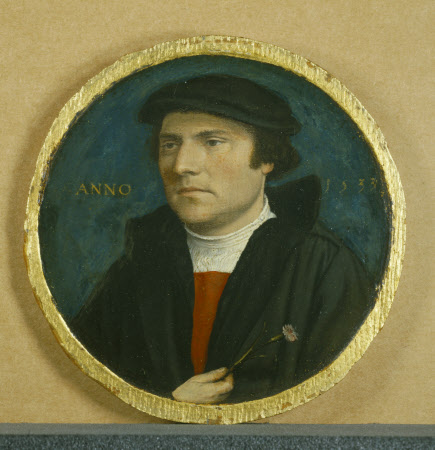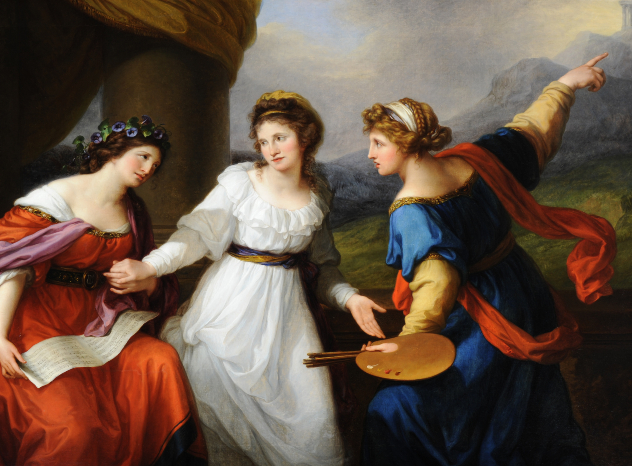A young man with a pink
Hans Holbein the younger (Augsburg 1497/8 - London 1543)
Category
Art / Oil paintings
Date
1533 (inscribed)
Materials
Oil on oak panel
Measurements
124 x 121 mm; 125 mm (Diameter)
Place of origin
England
Order this imageCollection
Upton House, Warwickshire
NT 446801
Caption
On the streets of Tudor London citizens would have encountered men and women from many different parts of Europe and beyond. They came to London as religious émigrés and as skilled merchants, professionals and artisans. This portrait probably depicts a German merchant of the London steelyard, one of several painted in the 1530s by the artist Hans Holbein the Younger (1497/8–1543). The young man is dressed in clothes appropriate for a merchant – a black cap, cloak and red tunic. He faces slightly to his right and looks thoughtfully into the distance. It is possible that the flower (known as a ‘pink’) he holds in his hand alludes to an engagement. This small-scale picture painted on a wooden board would have been easy to transport or send home to a loved one.
Summary
Oil painting on oak panel (circular), A Young Man with a Pink by Hans Holbein the Younger (Augsburg 1497/8 - London 1543), inscribed in gold ANNO (left centre) 1533 (right centre). A bust portrait against a blue background, facing slightly left, wearing a black cloak open at the neck showing a red tunic and white linen shirt, a flat black cap, holding a flower of the Dianthus species commonly known as a pink. Holbein is chiefly known as portrait painter to the court of Henry VIII. A German, he made his first trip to England in 1526 at the invitation of Sir Thomas More. His second visit in 1532 lasted until his death from the plague in 1543.
Full description
Our knowledge of the appearance of the courtiers and merchants of Tudor London is largely the legacy of the German artist Hans Holbein the Younger, whose extraordinarily vivid and evocative portraits remain outstanding in the history of this genre. This small portrait, dated 1533, is a masterful example of Holbein’s early miniatures, which he began painting following his second visit to London in 1532. The tondo format is one that Holbein particularly favoured when in England. It was sometimes used for portraits forming the bottom or lid of circular boxes. The sitter is likely to be an English or German merchant of the Hanseatic League which traded in the Thames-side Steelyard. Holbein received several commissions from the Steelyard merchants and in 1533, the year of this miniature, he was asked to design their City pageant for the coronation of Anne Boleyn. The breadth of Holbein’s skill was astonishing, encompassing miniatures and detailed drawings for goldsmiths along with large-scale portraits and subject pictures. Holbein is thought to have been taught to paint miniatures by one of Henry VIII’s court painters, Lucas Hornebolte (or Horenbout). According to the artist and historian Karel van Mander (1604), in a short time he as far excelled Lucas ‘as the light of the sun outshines that of the moon’.
Provenance
Franz Jäger, the elder (1743 - 1809), Vienna or Franz Jäger, the younger (1781–1839) and possibly the latter's posthumous sale, Vienna, 17–18 December 1841, lot 57 [if so, bought in, since reported by Waagen as in the possession of the elder's eldest son, Anton, in 1860]; Anton Jäger (1779 - 1865), Vienna; F. J. Gsell, Vienna (by 1866); his [posthumous?] sale, Vienna, 14 March 1872, lot 208 (bought by Plach); Fräulein Gabriele Pržibram, Vienna [and/or Prague?] (by 1891); thence by descent to Frau Leonore Goldschmidt- Pržibram, Brussels; her [posthumous?] sale, Frederick Müller, Amsterdam, 17 June 1924, lot 2, repd.; bought on behalf of the 2nd Viscount Bearsted by Agnew’s, for £3,720.14.7, plus 5% commission [£3,906.15.4]; given with Upton House to the National Trust by Walter Samuel, 2nd Viscount Bearsted (1882 – 1948) shortly before his death.
Credit line
Upton House, The Bearsted Collection (National Trust)
Marks and inscriptions
Recto: ANNO 1533 (dated) Verso: on a paper label, top left: City of Manchester Art Gallery 50 on a paper label, top right: The Rt Hon Viscount Bearsted on a paper label, covering the back panel: Hans Holbein / 1497-1543 / “Portrait of a Man” / Ex Collection Gsell / Jager / Lippman / Frauline Gabriele Przibram (Vienna) / Frau L Goldschimdt-Przibram (Brussels) / Reproduced in Klassiker der Kunst page 104 / Catalogue of “Exposition de la Miniature” Brussels 1912 (being plate 1) No. 855a / Described by Dr. Woltman in his “Holbein und Seine Zeit” as a portrait of Holbein himself / Dressed in the flat black cap and costume of the German merchants of the steelyard / (see Hans Holbein the Younger by Arthur B. Chamberlain, 1913, in which the Goldschimdt-Przibram picture is mentioned. Vol II, page 57 and 349) on a paper label fragment, bottom centre: Gallerie Gsell on a gilt wooden tablet, bottom centre: Jean HOLBEIN le jeune 1498-1543
Makers and roles
Hans Holbein the younger (Augsburg 1497/8 - London 1543), artist
Exhibition history
New Light on Old Masters, Squash Court Gallery, 2013
References
Waagen 1866 G. F. Waagen, Die Vornehmsten Kunstdenkmäler in Wien, Vienna, 1866, vol. I, p.317 Woltman 1868 A. Woltmann, Holbein und seine Zeit, Leipzig, 1868, vol. II, p.154, No.261 Frimmel 1891 T. Frimmel, Kleine Galeriestudien, Bamberg, 1891, p.293 Ganz 1912 P. Ganz, Holbein (Klassiker der Kunst), 1912, pp.104 (repd.), 241 Chamberlain, 1913: Arthur B.Chamberlain, Hans Holbein the Younger, 2 vols, London, 1913, vol.II, pp.57, 349 Ganz 1950 P. Ganz, The Paintings of Hans Holbein the Younger, London, 1950, p.244, No.77, pl.118. Strong 1980 Roy Strong, Holbein: The Complete Paintings, London, 1980, p.58, ill. p.58, no.80 Rowlands 1985 John Rowlands, The Paintings of Hans Holbein the Younger, Oxford, 1985, no.48, pp.140-41 & pl.86

